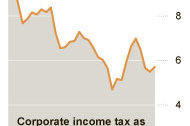Watch Out: You Are About to Pay A Lot More for Fresh Foods
Rich Hua stashed this in Food
Stashed in: Economics!, Vegetables!, Fruit!, Price Is Right!
Dammit. This makes me sad.
California is the largest domestic producer of each of the products Mr. Richards identified, ranging from grapes to peppers. And in the case of avocados, it’s the only state with a significant crop.
The drought has wiped out between 10% and 20% of California crops for the eight items, but the size of the expected price increases varies widely. Lettuce prices could jump as much as 34% and avocado prices could rise 28%, the largest projected increases.
“People are the least price-sensitive when it comes to those items, and they’re willing to pay what it takes to get them,” Mr. Richards said. “It’s hard to make a salad without lettuce.”
In basic economic terms, the drought reduces supply, which puts upward pressure on prices. But how high the price can rise is determined by consumers’ willingness to pay more against their ability to find a substitute.
Packaged salads, for example, would increase in price by only 13%, even though many of the ingredients in them are projected to increase in cost by a greater percentage. That’s because consumers view premade salads as a “luxury” good and would readily switch to lower-cost alternative if the price gets too high, Mr. Richards said. They could chop the lettuce themselves or buy frozen vegetables.
The impact could spread beyond the produce aisle. Items such as lettuce, tomatoes and peppers are commonly used in deli sandwiches and salsas, among other products. The drought could also cause those items to cost more.
Still, the run-up in prices is likely to be somewhat temporary, Mr. Richards said. When prices increase, farmers outside of California, including foreign suppliers, will be incentivized to ship more crops to the U.S. That will in turn put downward pressure on costs.
But with water-supply problems expected to persist for years, California farmers will have some difficult choices to make, he said. They’ll need to determine which crops should receive the limited amount of available water, and which should be allowed to fall away.
“We could be looking at future,” he said, “where California is no longer bread basket for the country.”











9:21 PM Apr 20 2014